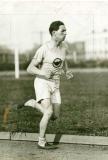Folders |
100 Years of History at The ArmoryPublished by
100 Years of History at The Armory By Doug Binder, ArmoryTrack.com and DyeStat.com
Friday marks 100 years of track and field at The Armory. It was Jan. 10, 1914, at an event called the Xavier Games, where the sport was first welcomed into what was then the Armory of the 22nd Regiment. And even on Day One of the building's long history of indoor racing there was a superstar in the midst. Abel Kiviat, from Staten Island, won the featured half mile and broke two minutes to generate the first headline for track at the armory. Kiviat won a silver medal at the 1912 Olympics and lived to the ripe old age of 99. The New York Times reported the next day: "The time, 1 minute 59 3-5 seconds, was agreed upon by good judges of foot running to have been quite the fastest ever witnessed in this territory." A hundred years ago, the landscape of Washington Heights was far different. It was largely an Irish neighborhood then. Less than two years earlier, across 168th street where New York-Presbyterian Hospital now stands, the New York Highlanders played their final games at Hilltop Park. By 1914, the Highlanders were known as the Yankees. Indoor track flourished in the city, and its numerous armories, and was a major spectator attraction. For the Xavier Games, several thousand spectators were reported to have witnessed Kiviat take on fellow Olympian Mel Sheppard and a few others. The meet included their race plus seven more foot races and the shot put. Five of the races were "handicapped," meaning slower runners ran shorter distances to make them more competitive. In the century since then, the building now officially called the New Balance Track and Field Center at The Armory, has been used for many purposes. It was, of course, a military installation. In the late 20th century it was a homeless shelter. But the presence of track and field weaves through all of that time. “I think it shows the lasting power of the sport in many ways,” Armory Foundation president Dr. Norbert Sander said. “People respond to the Olympics and the world wide appeal of the sport of track and in a way they don’t comprehend many of the others.” Within the report of the Times on the first armory track meet are details of the initial setup. "The arena in which the sports were held is the finest in the greater city, the eighth of a mile ellipse and 100 yard straightaway practically being 'lost' because of the expanse of the floor space. An army of regimental attendants looked after the shoes of the runners in order to preclude the use of spikes. The floor, which had been waxed for the opening regimental ball, was washed in order to make it uniform with the ideas of the athletes, who were held to the use of rubber-soled shoes, but whose efforts, in rounding the ends of the ellipse proved to be of the most guarded nature, all seeming fearful of slipping." Under those conditions, Kiviat's performance is all the more impressive. But he was also one of the great middle distance running talents of his age. A product of Curtis High School on Staten Island, the bow-legged, 5-foot-5, 110-pounder set three world records outdoors and six indoors. At the time of the Xavier Games he was the world record holder in the indoor 1,000 yards and the indoor mile. Kiviat died in 1991 and at the time of his death was the oldest surviving U.S. Olympian. For two nights at the 1912 Stockholm Games he roomed with famed multi-sport athlete Jim Thorpe. After his athletics career, Kiviat worked until he was 71 as a deputy clerk for the Southern District of the United States Federal Court in Manhattan. “I met him in the early days of the New York Road Runners so I remember him a little bit,” Dr. Sander said. “He was somebody who stayed right with (the sport) and availed himself to do things in running.” In the intervening 100 years since Kiviat christened the Armory’s third-story hardwood floor with his rubber-soled sneakers, the arena has been home to one generation of track and field athletes after another and been the site of scores of world and U.S. records. “We’ve had track in this building for 100 years and it’s probably one of the very few places in the world that could say that,” Dr. Sander said. “It can last another 100 years at the Armory.”
3 comment(s)
|







